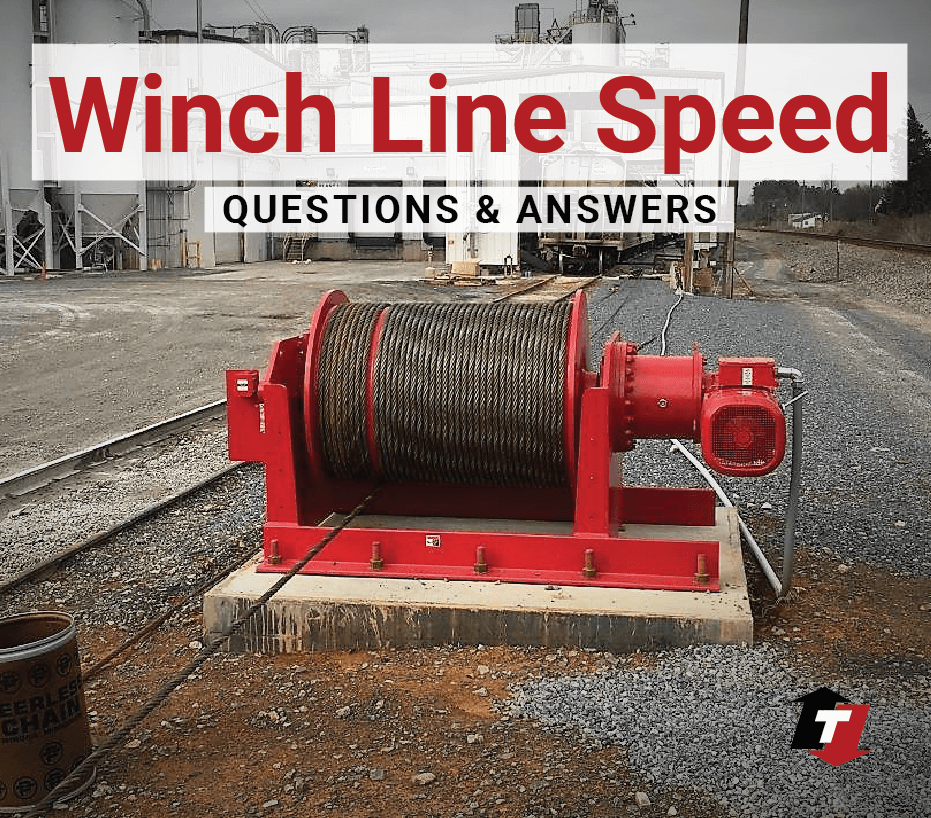Winches may seem simple, but understanding their nuances is key to efficient and safe operation. A central concept is line speed – how fast the rope or cable moves. It’s more complex than you might think! The truth is not all winches are best suited for your application based on various factors including load rating. Drawing on insights from our seasoned Thern tech team, we’ve broken down common misunderstandings around line speed.
6 Line Speed Answers You Need To Know
Q1: What is line speed, and why is it important?
A: Line speed is simply the rate at which the rope spools onto the winch drum, measured in feet (or meters) per minute. It dictates how quickly a load moves. But it’s not just about speed; line speed impacts the winch’s lifespan, the safety of your operation, and the precision of your lifts.
Think of it like carrying a bucket of water. It’s easier when the bucket is close to your body than when you hold it out at arm’s length. The farther out you hold it, the more effort it takes, and the slower you must move to keep it steady. With Winches, It’s a trade-off between speed and power. When the drum is nearly empty, the winch has maximum line pull but slower line speed. As the drum fills with rope, line speed increases, but line pull decreases.
Key Point from Our Engineers: Safety is the top priority! Always consider if it’s safe to move the load at a certain speed, considering the distance, the operator’s and the equipment’s safety, and the winch’s mechanical capabilities.
Q2: What’s the difference between line speed and line pull?
A: Line speed is the rate that the winch can move a load from point A to point B. Whereas line pull is the force or tension that the winch applies to the rope that will lift or pull the load.
Myth Buster: You don’t always need a 6,000 lb load rating on your winch for a 6,000 lb horizontal pull. Factors like friction and the angle of the pull affect the required line pull.
Q3: How does the load weight and amount of cable on the drum affect speed?
A: For electric winches, the speed at which the rope pulls in (line speed) stays the same, even if the weight of the load changes. But for air winches, the line speed slows down as the load gets heavier.
With electric winches, there’s an interesting twist: the line speed gets faster as more rope layers build up on the drum. This happens because the electric motor keeps spinning at the same speed, but the larger diameter of the rope-filled drum means more rope is pulled in with each rotation.
Analogy: Think of a merry-go-round. The farther from the center you are, the faster you go, even though the merry-go-round itself turns at the same speed.
Q4: What are the safety implications of using the wrong speed for a particular load or application?
A: Too high a speed can cause dangerous shock loading when starting or stopping. For lifting, excessive speed can lead to uncontrolled swinging and inaccurate stop positioning.
Key Point from Our Engineers: It’s crucial to select the appropriate speed that allows for smooth, controlled movement to prevent shock loading, ensure accurate stopping, and protect both the operator and the equipment.
Q5: Variable vs. Fixed Line Speed: What’s the difference?
A: Variable speed winches offer flexibility, allowing operators to adjust speed for different tasks. This reduces shock loads and helps prevent overloading the winch. Fixed-speed winches are simpler and more affordable but lack this adaptability.
Q6: How do gear ratio and horsepower affect line speed and pulling power?
A: For electric winches it means:
- More horsepower: it can lift or pull heavier things.
- Lower gear ratio: Less pulling/lifting power, but faster line speed.
- Higher gear ratio: More pulling/lifting power, but slower line speed.
Key Points from the Tech team: It’s all about finding the right balance for the job you need to do. Need to lift something heavy? You’ll want more horsepower and a higher gear ratio. Need to move something quickly? A lower gear ratio might be better, but you won’t be able to lift as much weight without additional horsepower.
Additional Considerations:
- Distance the load needs to travel
- Frequency of operation (and service factor)
- Time constraints for the job
- Potential for shock loading
Thern’s Approach:
At Thern, we carefully design our winches with optimal gear ratios for specific applications. For variable speed, we integrate advanced motor and drive features to provide the widest possible range of speed adjustments.
Understanding line speed is key to unlocking the full potential of your winch. It’s about more than just speed; it’s about finding the safest balance for your specific task.
Need help finding that balance? Thern’s got your back! Contact our experts today, and let’s find the perfect winch for your needs.
If you found this article interesting, you may also be interested in this one:
